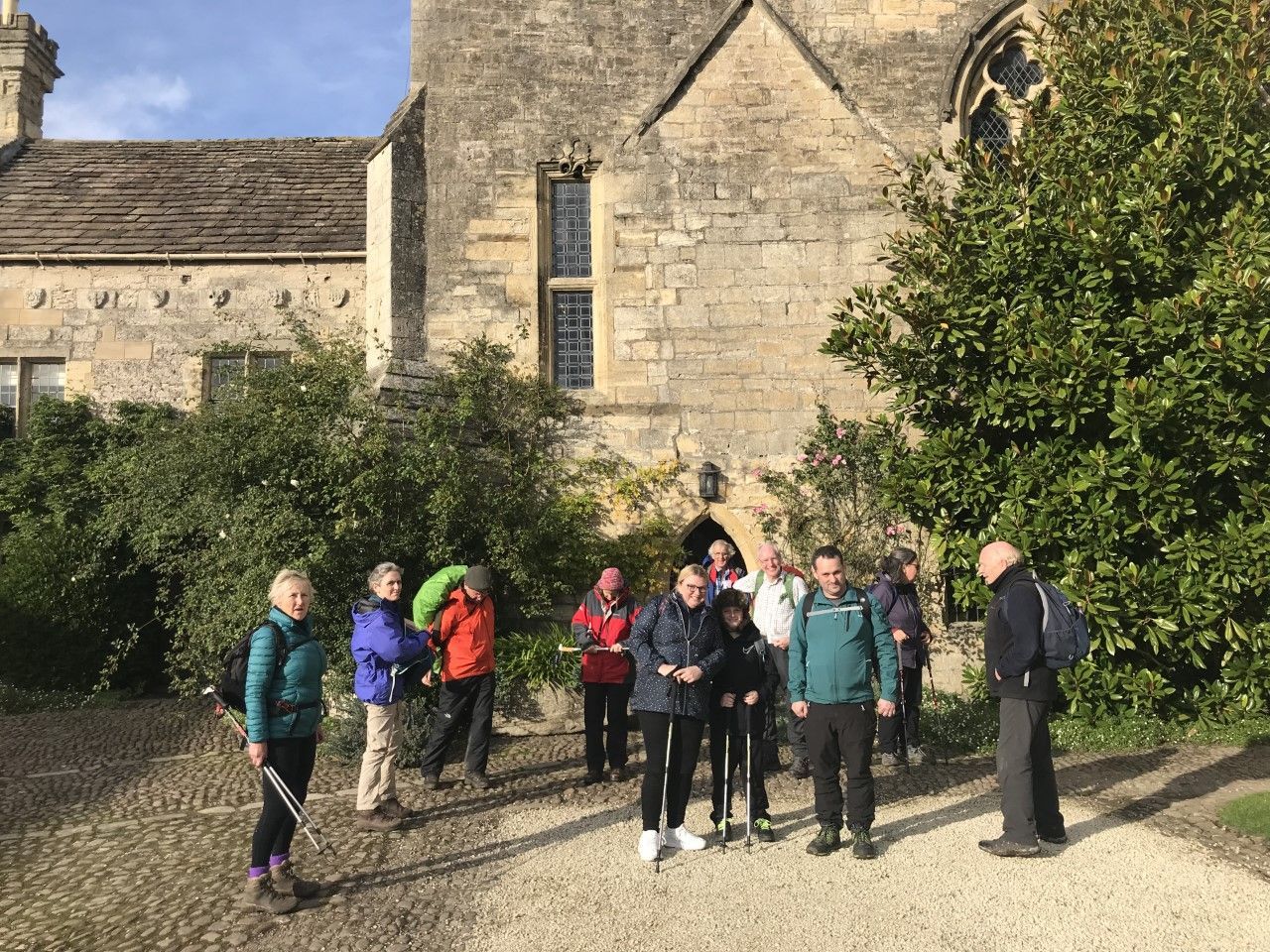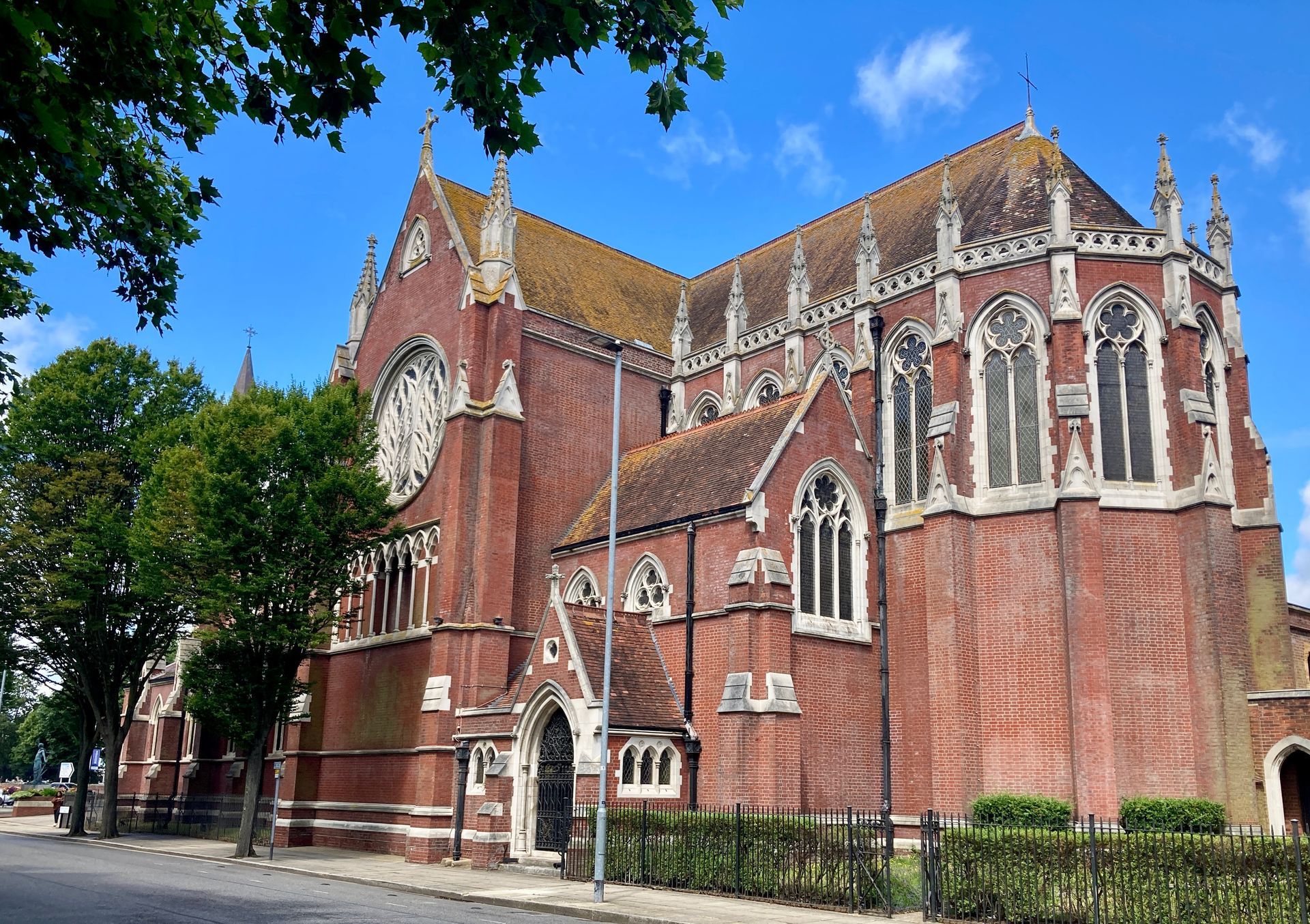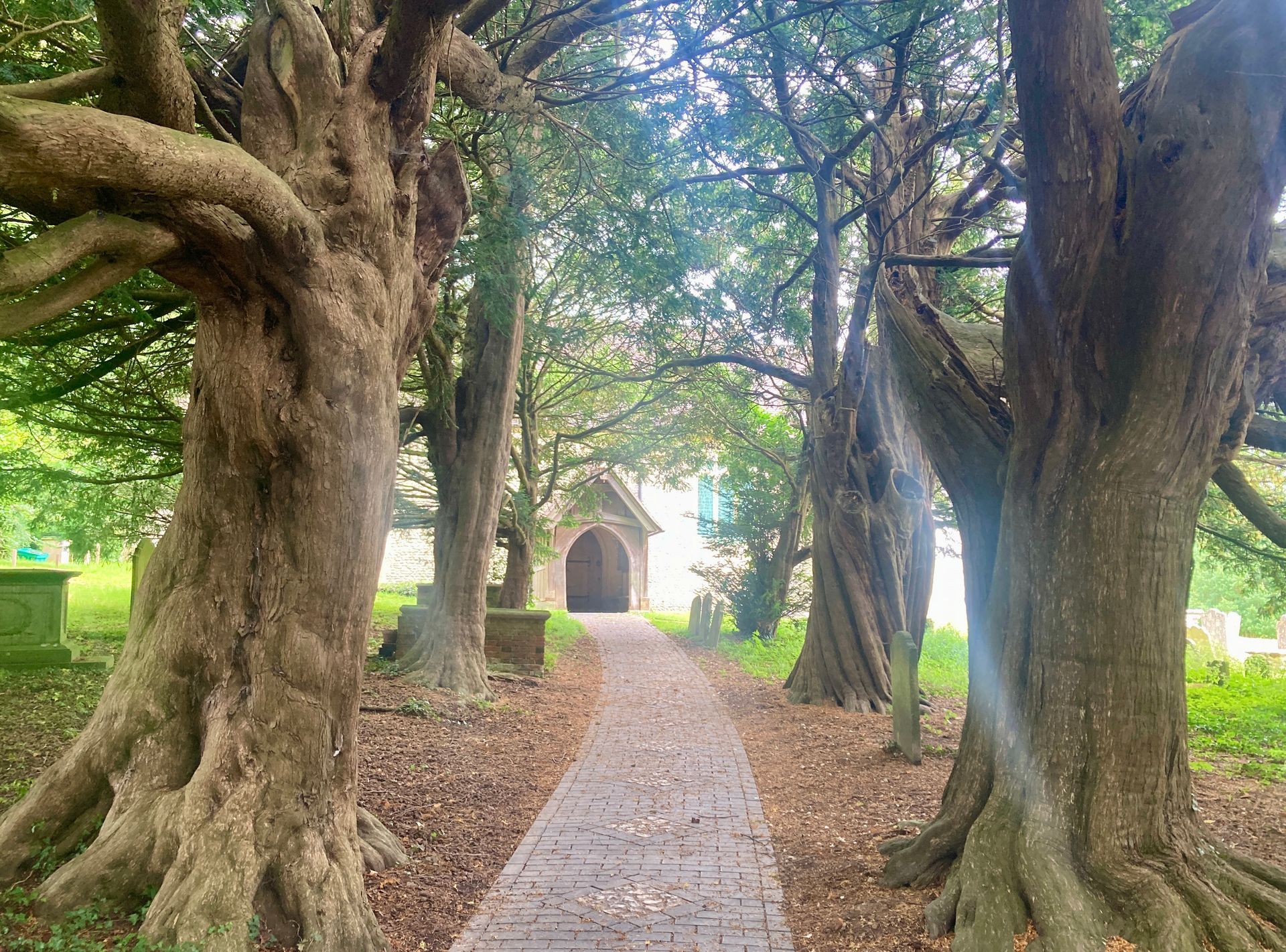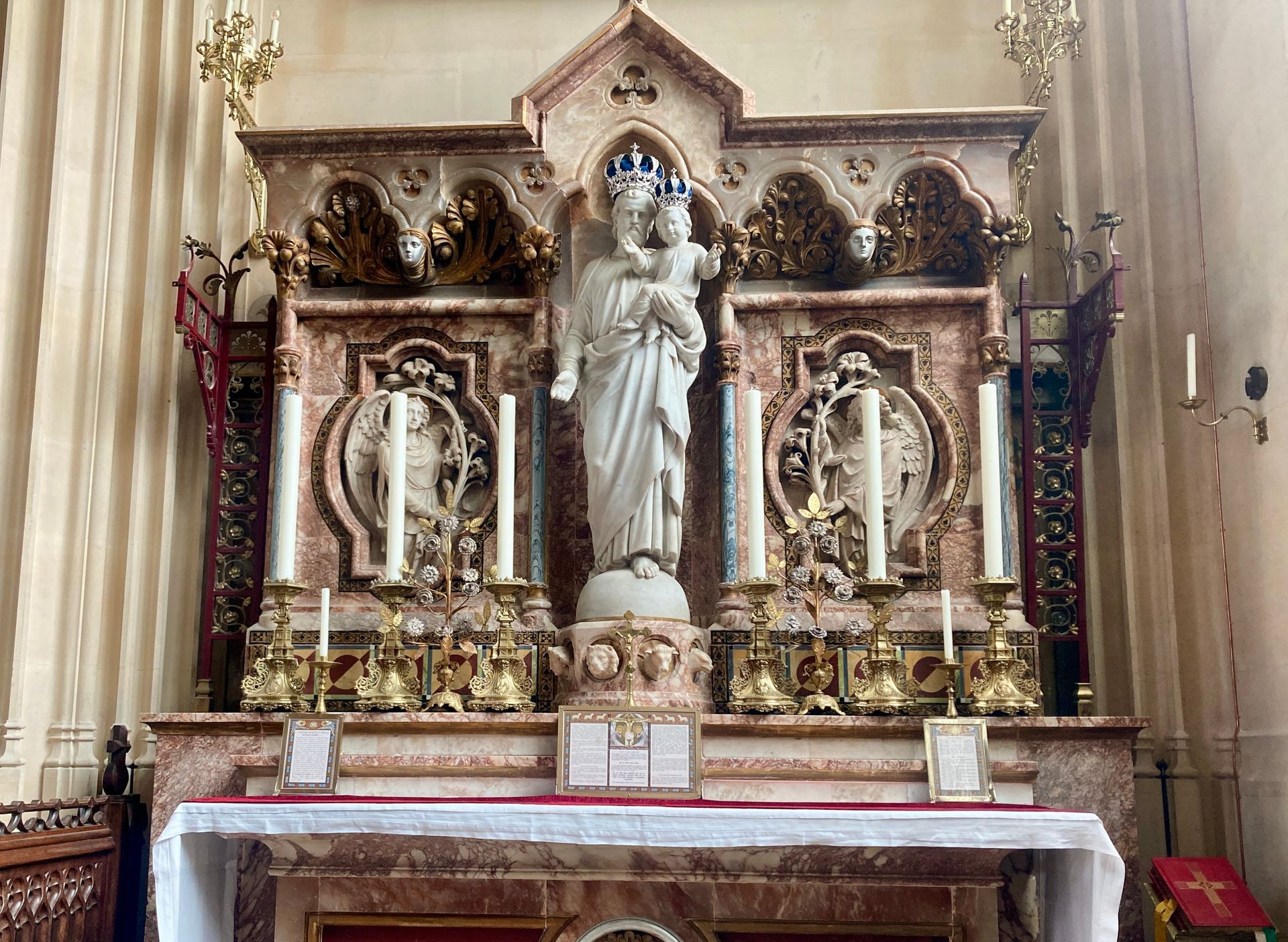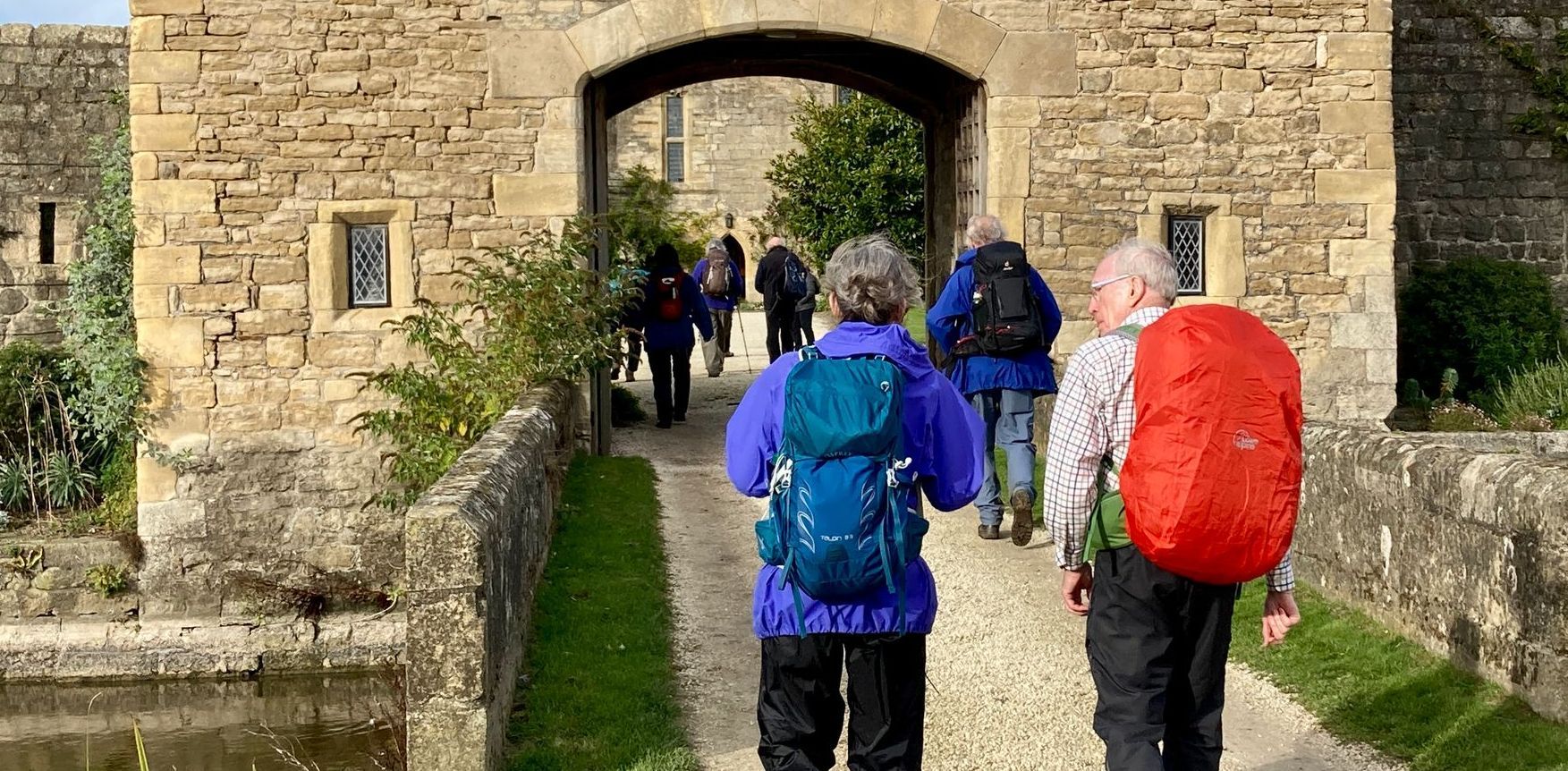St Joseph's Way
A Pilgrim Way for the Bishopric of the Armed Forces from the Cathedral of St John in Portsmouth to the Cathedral of the Bishopric of the Armed Forces at Aldershot and then on to the National Shrine of St Joseph in Farnborough Abbey
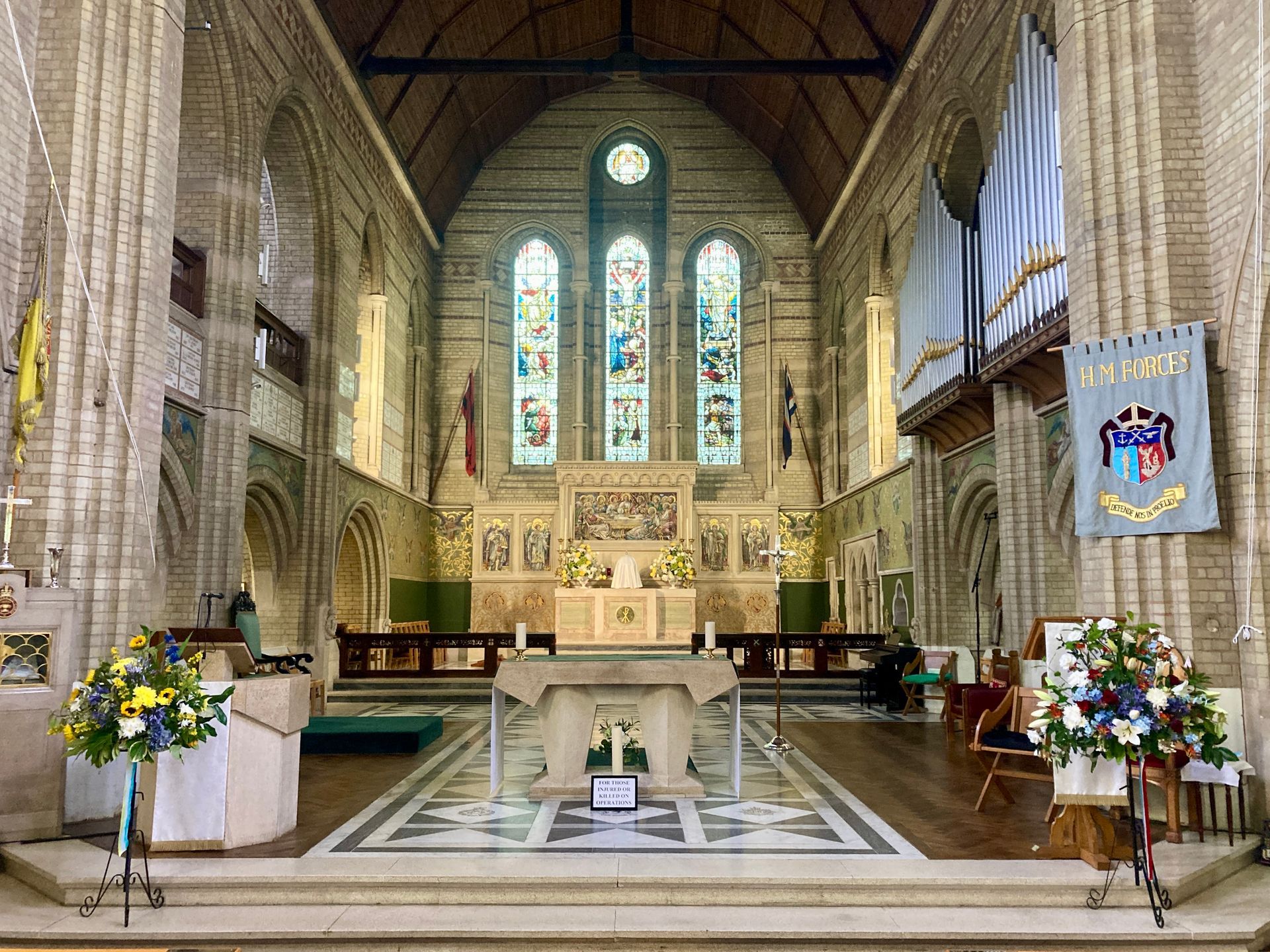
The Cathedral of SS Michael & George, Aldershot
About the route
From St John's Cathedral the Way passes the Church of Corpus Christi in Portsmouth and then joins the Pilgrims' Trail out of Portsmouth passing the Church of St Colman at Cosham. At Wood End the way joins the Meon Valley Churches Walk along a disused railway track to West Meon. The Pilgrim Way then crosses farmland by track and lane to reach Ropley where the route joins the St Swithun's Way, to reach the Church of St Mary, Alton.
Just before Hale the route leaves the St Swithun's Way, to reach the Church of St Joan of Arc in Farnham and then the Church of the Holy Family before crossing parkland to Aldershot and the Church of St Joseph and then the Cathedral of SS Michael & George, of the Catholic Bishopric of the Armed Forces. The Way picks up the Basingstoke Canal towpath and then the Blackwater Valley Path into Farnborough to reach the Shrine of St Joseph at Farnborough Abbey.
You can find out more about the Way and download the GPX file by clicking on the LEARN MORE tab in the
interactive map below
Guidance
You can use the tabs in this section to find the information you need for your pilgrimage.
The Outer Way provides practical advice about the route.
The Inner Way describes the spiritual highlights.
Walking guidance: you can use the button to download the details of the inner and outer way, walking guidance and maps.
Stages: route, food & drink, accommodation and public transport
1. The Cathedral of St John, Portsmouth to the Church of St Colman, Cosham – 4.6 miles
The route is urban until the Way joins the Pilgrim’s trail beside Tipner Lake. There are plenty of shops, pubs, cafés, restaurants and accommodation in central Portsmouth. There is a café by Tipner Lido. There are also shops, pubs and cafés in Cosham. The Cathedral can be reached by foot from Portsmouth & Southsea Railway Station. It is a slightly longer walk or short bus trip from Portsmouth Harbour Railway Station and The Hard coach station. There are trains and buses from Cosham back to central Portsmouth.
2. The Church of St Colman, Cosham to the Roebuck Inn, Wickham – 9.5 miles
The Way is suburban until Southwick Hill is crossed. It is then along quiet lanes and farm tracks, passing through the picturesque village of Southwick and then on to reach West Walk, part of the Forest of Bere. There are pubs and a shop in Southwick, a mobile café in West Walk and finally the Roebuck Inn (in 2024 this became an Indian gastro pub). There are occasional buses from Southwick to Cosham and from the Roebuck Inn to Wickham. There is no accommodation enroute.
3. The Roebuck Inn, Wickham to West Meon – 8.6 miles
The path joins the Meon Valley Trail and follows this all the way to the delightful village of West Meon. There are pubs just off the route at Soberton, Droxford & Meonstoke (NB check opening times before you divert). There is a pub, a village shop and Airbnb accommodation in West Meon and a bus service to Petersfield and Winchester.
4. West Meon to Ropley – 6.8 miles
The Way gently climbs the South Downs and descends to Ropley. The route is mostly tracks and paths, some of which may be overgrown. There is a shop and café in Ropley and a bus service to Winchester and Alton. There is no accommodation.
5. Ropley to the Church of St Mary, Alton – 8.1 miles
The route joins the St Swithun’s Way and follows this across farmland to Alton, passing the former home of Jane Austen at Chawton. There are pubs and cafés in Chawton, and all facilities in Alton including an outdoors shop on the High St. There is a regular bus and train service from Alton.
6. The Church of St Mary, Alton to the Church of St Joan of Arc, Farnham – 11 miles
The path continues to follow the St Swithun’s Way, passing the former home of Lord Baden-Powell. It diverts through Dippenhall to talk a more direct route into Farnham. There is a pub with accommodation at Lower Froyle. There are all facilities in Farnham and good bus and train service.
7. The Church of St Joan of Arc, Farnham to the Cathedral of SS Michael & George, Aldershot – 4.9 miles
The Way crosses parkland to the Heath End and then skirts woodland before passing through suburban areas to Aldershot. There is a pub at Heath End opposite the church, and all facilities in Aldershot just off the route. There is a good bus service and a railway station.
8. The Cathedral of SS Michael & George, Aldershot to the Abbey of St Michael & the National Shrine of St Joseph, Farnborough – 5.5 miles
The route concludes with a walk beside the Basingstoke Canal and then along the Blackwater Valley. There are picnic benches at Ash Lock and a pub at North Camp. There are shops, pubs and cafés in Farnborough. It may be possible to stay at the Abbey by prior arrangement. There is a good bus service from Farnborough and two railway stations near the Abbey.
Public transport links
Trains:
https://www.nationalrail.co.uk/
Coaches:
https://www.nationalexpress.com/en
Buses:
Pilgrim people and places
NB Many churches are closed during daylight hours. If you would like to visit the churches and shrines it is best to check the parish website first. You can also email or phone the parish office to see is someone would be willing to open the church. Please be aware that many priests cover more than one church and so may live many miles away.
The Cathedral of St John, Portsmouth
Catholic practice virtually disappeared in Portsmouth after the Reformation, and until 1791 those few Catholics who remained were served by the chaplains attached to the households of old Catholic families. After the French Revolution, many French and other priests sought refuge in the Portsmouth area, and several chapels were built. In 1880 the foundation stone for a substantial red brick and stone Decorated Gothic church was laid. When the Diocese of Southwark was divided in 1882 the new Diocese of Portsmouth was created, and the church became the cathedral. The incomplete building (five bays of the nave) was consecrated in 1887 and several extensions were made over the years. St Patrick’s chapel was added in 1924. In 1941 the Cathedral and Bishop’s House were extensively damaged by bombing. Rebuilding and restoration followed in 1946-50. The sanctuary has undergone several re-orderings, the most radical in 1971, when a new Portland stone altar with ceramic figures was installed.
The Church of Corpus Christi, Portsmouth
Corpus Christi was opened in 1893, the third Catholic church to be opened in Portsmouth. Initial plans were ambitious but had to be scaled back due to costs. According to the centenary Mass booklet the church ‘could only be described as a huge barn’! The sanctuary and aisles were added between 1894 and 1900, and the high altar bought from a Ryde convent. This plain brick church has Perpendicular Gothic external details, an attractive spacious interior and some good furnishings. The church is part of the parish of Corpus Christi & St Joseph.
The Church of St Colman, Cosham
Fundraising for a church in Cosham started in 1921 and building started in 1927. The church was opened in November 1928. St Colman was the patron saint of the then Bishop’s native diocese of Cloyne and built to seat 400. It is a late Gothic Revival church, drawing upon regional traditions in its design and materials. The sanctuary was reordered in 1969 and a church hall was built in 1973. The church is part of the parish of St Colman & St Paul.
The first Catholic church in Alton opened in 1911. In 1938 a larger temporary church was built on the site of the present building. The foundation stone of the present church was laid in 1966 by Bishop Worlock and the church was completed later in that year. The church was consecrated in 1982. It is one of the churches built in the wake of the Second Vatican Council which experimented with new forms. The most distinctive features of the church are the stepped roof, the centrally planned internal space, and the stained-glass panels.
The Church of St Joan of Arc, Farnham
The church was built in 1930, and dedicated to St Joan of Arc, who had been canonised ten years earlier. The architect was John Edward Dixon-Spain who went on to design film studios and many Catholic schools. The church is built in red brick with a steeply pitched tiled roof and tall, open-arched, campanile. The style is described as ‘loosely Romanesque’. There is a statue of St Joan over the entrance to the narthex. The church is part of the Diocese of Arundel & Brighton.
The Church of the Holy Family, Heath End, Farnham
After WWII Mass was said at Parkside, home of the Wright family. By the 1950s numbers had become too great, and plans were made for a church. A chapel was opened in 1954. In 1971 the building was extended, and the small steeple and hall were added. The church has 14 stained-glass windows by Moira Forsyth (1905-91) who lived locally. She designed stained glass windows for many famous locations, but these, for the church in which she worshipped, are said to be her finest. There is a chapel dedicated to St Joseph with a delicately carved wooden statue. The church is set back from the road and, unusually for a Catholic church in England, it has a lychgate. There is a wooden cross and a pieta in the grounds. The church is part of the parish of Holy Angels & Holy Family within the Diocese of Arundel & Brighton.
The Church of St Joseph, Aldershot
In 1872 a site was purchased in Queen’s Road, and St Joseph’s school and school chapel opened in November of that year. A tin church was built adjacent to the presbytery in 1883. The foundation stone for the present church was laid in 1902 and the church was opened in 1913 and consecrated in 1982. The architect was George Drysdale (1881-1949) who later rebuilt the fire-damaged Houses of Parliament in Ottawa, Canada. It is a fine red-brick early-C20 church in the style of a basilica on a triangular site. The church is part of the Aldershot Catholic Community parish. We are now back in the Diocese of Portsmouth!
The Cathedral of SS Michael & George, Aldershot
The church was designed in 1892 in the Early English Gothic Revival style to be the principal church for the Anglican chaplaincies of the British Army. The foundation stone was laid by Queen Victoria. Catholics worshipped nearby in a large wooden barn like building. By the early 1970s St George's was not needed by the Anglican chaplaincies and the number of Catholic soldiers was increasing, so in 1973 the church became the seat of the Catholic Bishop of the Forces and was dedicated to SS Michael & George. The Blessed Sacrament Chapel was constructed in 1998. In 2015 a crucifix made from the parts of 23 aircraft from the 1930s to the present was blessed and dedicated in the cathedral as a link to all who serve in the RAF. The Royal Army Service Corps holds a memorial service in the Cathedral each year and their Chapel of Remembrance is to the south of the Sanctuary.
The Abbey of St Michael and the National Shrine of St Joseph, Farnborough
After the fall of the 2nd French Empire in 1870, Napoleon III, his wife Empress Eugénie and their son the Prince Imperial were exiled and lived at Chislehurst, Kent. When Napoleon III died in 1873, he was buried at St Mary's Church in Chislehurst. After the death of the Prince Imperial in 1879, Empress Eugénie founded Farnborough Abbey in 1881 as a mausoleum for her husband and son. She was later buried alongside them.
The Abbey Church was designed in an eclectic Gothic style. It contains the thigh bone of St Alban. The church and monastery were initially administered by Premonstratensian Canons. In 1895, the Empress replaced them with French Benedictine monks from St Peter's Abbey, Solesmes. The community was depleted by 1947, and most of the remaining monks dispersed to other houses of their Congregation. Farnborough was resettled by a group of English monks from Prinknash Abbey in Gloucestershire, part of the Subiaco-Cassinese Congregation, the largest of the congregations of the Benedictine Confederation including St Benedict’s own monasteries of Monte Cassino and Subiaco. In 2006, the community elected the first English Abbot of Farnborough. The community is small and young, and the monks live the traditional life of prayer, work and study according to the Rule of St Benedict. At the heart of their life is the dignified celebration of the daily round of the Mass and Divine Office.
The statue of St Joseph in a side chapel to the right of the high altar in the monastery church initially belonged to the Mill Hill Fathers at St Joseph’s College. It was crowned by Cardinal Manning with special permission granted by Blessed Pope Pius IX. The statue has been a focus of devotion for over a century to that great silent saint, Patron of the universal Church. When St Joseph's College closed in 2006 Farnborough Abbey agreed to receive the Shrine's statue and altar, and the present National Shrine was erected in 2008.
ABOUT THE BISHOPRIC OF THE ARMED FORCES
The Catholic Bishopric of Her Majesty's Armed Forces is a diocese whose boundaries extend to wherever the British Military are serving. Its mission is to provide the very best operational, spiritual and pastoral support, primarily for Catholic servicemen and women and their families wherever, whenever and in whatever form it is needed. Additionally, to respond to the needs of anyone of any creed or none, who turns to a Catholic chaplain for support.
Providing pastoral ministry to our Armed Forces is essential. It is a concrete example of the Church’s outreach in bearing witness to Christ, which the Bishopric endeavours to achieve in a military environment. Pope Francis tells us the Church should be like a field hospital and military chaplains take that literally. The Bishopric's chaplains are to be found in the most challenging of times and places bringing prayer, sacraments, friendship and fellowship to those they serve.
Copyright Hearts in Search of God - Pilgrim Way Project (England and Wales)
Web Design by Catholic Marketing Agency: Every Day Christian Marketing
